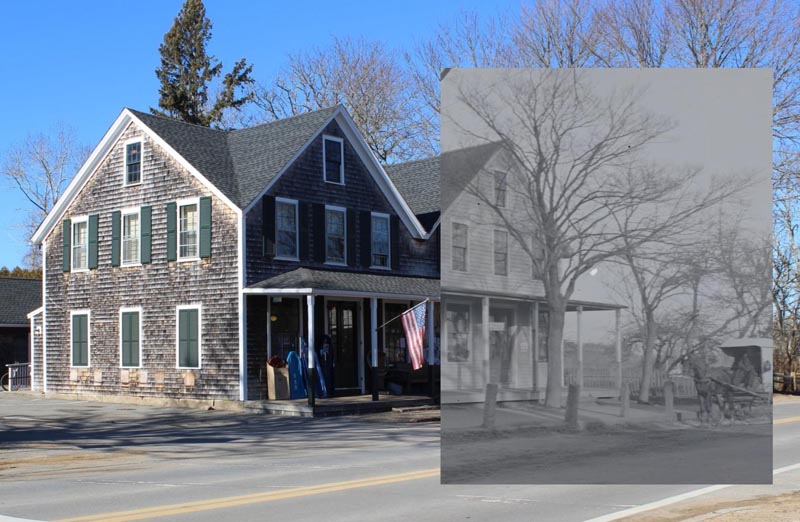“Lost and Found,” the latest exhibit at the Martha’s Vineyard Museum, is made up of photos and written and oral histories which spotlight some of the Island’s most iconic structures — some still standing, some repurposed, and some gone with the passage of time.
Alongside each historic photo is a contemporary shot of the same site with or without the original defining home or business. Exhibit curator Anna Barber spent months traveling around the Island on a photo shoot project, lining up the shots so that they correspond as closely as possible to scenes in the museum’s archival photos.

“My goal was to pick distinctive enough places that have recognizable features, so that when you look at the old picture, without looking at the counterpart, you say ‘I know that,’” Ms. Barber said. “I think that is the most compelling part. It allows you to do a little bit of time traveling.”
Among the “found” sites are the Corner Store in Oak Bluffs, which, aside from the 1940s/50s era cars parked out front in the old photo, looks exactly the same; the building that houses the clothing store Bananas in West Tisbury, which previously served as a Post Office, bookstore, candy shop, and a myriad of other businesses; and, of course, the iconic Alley’s General Store, which like the Corner Store has virtually not changed at all in appearance or purpose.
Looking at the old photos of the latter two businesses — with horse and buggy out front or motorists passing by in an antique car — one is reminded of the days when the Island was a little less commercial. But take a look at some shots of the former roller skating rink and the Seaview Hotel down by the Steamship Authority dock, and one can see that Oak Bluffs has always been a center of activity and entertainment. “The roller rink was huge,” Ms. Barber said. “It took up a very large part of town. When the Seaview burned down, it took the roller rink with it.”
Another lost Oak Bluffs landmark is quite hidden, and far less well known. The former Baptist church, located in the highlands behind New York Avenue, was the Baptist equivalent of the Campground’s Methodist Tabernacle, according to Ms. Barber. “If you look at a map, the roads back there all circle around a little grove,” she said. “The building was dismantled. Now all that’s left are some little bits of concrete.”
One structure featured in the exhibit has not only changed dramatically in appearance, but was recently moved. The Gay Head Lighthouse is pictured in archival photos with a huge lightkeeper’s house attached to it. The brickyard, another up-Island landmark which has since all but disappeared, can be rediscovered through photos in the “Lost and Found” exhibit.
Some of the “found” buildings attest to the timeless nature of the Island. The Kelley House in Edgartown looks virtually the same today as it did when it was established in the 1700s. “The Kelley House may be the oldest continuously operated business on the Island, along with the Allen Farm,” Ms. Barber said.
Other structures speak of the Island’s interest in honoring its past. The Workshop Gallery on Beach Road, next to the Gannon & Benjamin Marine Railway, was christened with a nod to the building’s former occupant. In the 1930s through ’50s, the structure served as a workshop for the Van Ryper business, which created wooden ship models and provided scale models for military strategists during WWII.

In a press release for the exhibit, Ms. Barber wrote, “The museum explores iconic Island structures both lost and still standing. Some have been lost to time, destroyed by fire, or left to decay, while others have survived with a new identity or purpose. They all, however, have stories to tell of a dynamic and resilient Island.”
The museum hopes to expand upon the exhibit by eventually creating a more comprehensive collection through a website and possibly a book. Guests to the museum will have the chance to write down suggestions for other “Lost and Found” locations on the Island to be included in continuing research.
There will also be walking tours and other events surrounding the exhibit in the near future. Check the museum’s website for further developments.
“Lost and Found” will be on display at the museum until June 3, with an opening reception on Monday, Feb. 13, at 4 pm. For more information, visit mvmuseum.org.




